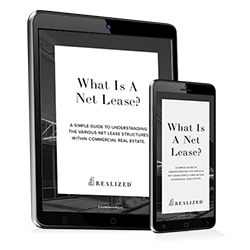
Direct and sole ownership is one of the most common ways to invest in a triple net (NNN) lease asset, but certain situations or financial goals make fractional ownership a more appealing and practical option. Fractional ownership is simply a model where multiple people share the ownership of an asset. So, how does it work? What are the different types of fractional ownership? Realized 1031 shares the answers in this insightful guide.
What Is NNN Lease Fractional Ownership?
As the root word “fraction” implies, fractional ownership is an investing method where an individual only owns a part of an asset. The primary purpose of this approach is to lower the barrier to entry for investors. Since you’re only purchasing partial ownership, the capital needed won’t be as large as the funds for directly owned properties.
Investing in an NNN property through fractional ownership is popular because of one major factor: most NNN properties are high-value assets. Direct ownership is usually only possible for the ultra-wealthy, but fractional ownership allows small-time investors to access NNN investments more easily.
Types of Triple Net Lease Fractional Ownership
There are a few types of investments that follow a fractional ownership model. Each has specific features, requirements, and risks, so it’s essential to learn the differences in order to choose one that suits your financial needs.
Here are a few popular examples.
Delaware Statutory Trusts
A Delaware Statutory Trust (DST) is a legal structure that owns underlying income-generating assets. You enter by purchasing beneficial interests, and in exchange, you earn monthly income from the revenue of the properties. Many DSTs own institutional-grade NNN properties, which gives you access to the income from these high-value assets.
DSTs are also eligible for 1031 exchanges. Finishing the 1031 exchange by acquiring beneficial interests allows you to defer capital gains taxes, preserving more of your wealth.
Umbrella Partnership Real Estate Investment Trusts
An umbrella partnership real estate investment trust (UPREIT) has a similar structure to DSTs, owning income-generating properties that may include NNN assets. However, the difference is that you contribute an existing real estate asset in exchange for operating partnership (OP) units. You earn dividends based on the units you own.
UPREITs are popular because of their tax deferral benefits. You’re only liable once you convert the OP units to REIT shares.
Tenancy in Common
Under a tenancy-in-common (TIC) structure, two or more people co-own a single property. Each owner receives an individual deed for their specified, undivided fractional interest in the entire property. Thanks to this feature, TICs allow you to individually sell, mortgage, or bequeath your fractional share without consulting the other owners.
Benefits of Fractional Ownership in NNN Investing
Both sole and fractional ownership have their merits. However, the latter may be more suitable for certain types of investors, especially those who prioritize the following.
- Lower Barrier to Entry: Fractional ownership doesn’t require huge capital, especially in the context of NNN investing.
- Passive Income: You earn a proportional share of the rental income without the hassle, time commitment, and stress of being a landlord or managing a property yourself. NNN assets, by themselves, already offer some management relief. However, some structures bring the hands-off involvement to the next level.
- Diversification and Risk Management: Since fractional ownership investments have a lower barrier to entry, you can enter multiple investments at once. This characteristic heightens diversification, leading to lower risk.
Wrapping Up: The Basics of Triple Net Lease Fractional Ownership
NNN investing can be more accessible when you enter it through fractional ownership. You don’t own the property wholly, but you can still earn income from its operations. Options like UPREITs, DSTs, and TICs are a few examples that follow this structure, offering benefits like passive income and diversification. These structures allow investors to tap into the stability of long-term leases with minimal landlord responsibility at a fraction of the cost.
Sources:
https://www.investopedia.com/terms/t/tenancy_in_common.asp
https://www.delawareinc.com/blog/what-is-a-delaware-statutory-trust/
https://www.investopedia.com/terms/u/upreit.asp
https://www.investopedia.com/terms/f/fractionalownership.asp



